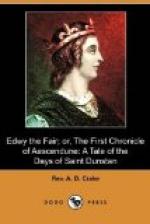Ransomed by their Saviour’s merits;
This the price their freedom cost:
City of eternal refuge,
Haven of the tempest-tost.
IV.
Fierce the blow, and firm the pressure,
Which hath polished thus each stone:
Well the Mastermind hath fitted
To his chosen place each one.
When the Architect takes reck’ning,
He will count the work His Own.
V.
Glory be to God, the Father;
Glory to th’ Eternal Son;
Glory to the Blessed Spirit:
One in Three, and Three in One.
Glory, honour, might, dominion,
While eternal ages run.
Amen.[xx]
The grand strains seemed to bring assurance of Divine aid to Alfred, and he could but imitate Father Cuthbert, who lifted up his stentorian voice and thundered out in chorus, as they drew near the pilgrims.
Here they left the Foss Way for the side road leading to the monastery, now only a short distance from them.
CHAPTER XI. THE FLIGHT OF DUNSTAN.
It was the day of St. Alban, the protomartyr of England, and the saint was greatly honoured at Glastonbury, where, as we have seen, Dunstan was in residence, and, as a natural consequence, every department of the monastic life was quickened by his presence. The abbey was full of monks who had professed the Benedictine rule, and having but recently been rebuilt, it possessed many improvements hardly yet introduced into English architecture in general. The greater part of the building was of stone, and it was not, in its general features, unlike some of the older colleges at Oxford or Cambridge, although the order of the architecture was, of course, exclusively that of the Saxon period, characterised by the heavy and massive, yet imposing, circular arch.
But upon the church or abbey chapel all the skill of the architect had been concentrated, and it seemed worthy alike of its founder and of its object. Seen upon the morning in question, when the bright summer sun filled every corner with gladsome light, just as the long procession of white-robed priests, and monks in their sombre garb, with their hoods thrown back, were entering for high mass, and the choral psalm arose, it was peculiarly imposing.
The procession had not long entered the church, when the party of pilgrims we have described, closely followed by our friends from Aescendune, entered the quadrangle, and crossed it to the great porch of the church. It was with the greatest difficulty they could enter, for the whole floor of the huge building was crowded with kneeling worshippers. The portion of Scripture appointed for the epistle was being chanted, and the words struck Alfred’s ears as he entered—“He pleased God, and was beloved of Him, so that, living among sinners, he was translated.”
The words seemed to come upon him with special application to the danger the great abbot was in, and the thought that the martyr’s day might be stained by a deed of blood, or, as some might say, hallowed by another martyrdom, added to his agitation.




